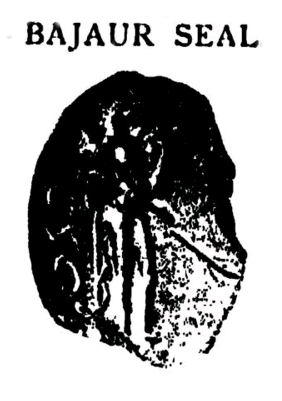Theodamas on:
[Wikipedia]
[Google]
[Amazon]
 Theodamas ( ''fl.'' 1st century) seems to have been an
Theodamas ( ''fl.'' 1st century) seems to have been an
Bajaur seal inscription of Theodamas (Gandhari.org)
{, align="center" cellpadding="2" border="2" , - , width="30%" align="center" , Preceded by:
... , width="40%" align="center" , Indo-Greek Ruler
(1st century) , width="30%" align="center" , Succeeded by:
... Indo-Greek kings 1st-century monarchs in Asia
 Theodamas ( ''fl.'' 1st century) seems to have been an
Theodamas ( ''fl.'' 1st century) seems to have been an Indo-Greek
The Indo-Greek Kingdom, or Graeco-Indian Kingdom, also known historically as the Yavana Kingdom (Yavanarajya), was a Hellenistic-era Greek kingdom covering various parts of Afghanistan and the northwestern regions of the Indian subcontinent ( ...
ruler in the Bajaur
Bajaur District ( ps, باجوړ ولسوالۍ, ur, ) is a district in Malakand Division of Khyber Pakhtunkhwa province in Pakistan. Until 2018, it was an agency of the Federally Administered Tribal Areas, then during restructuring that merg ...
area of Gandhara, in modern Pakistan
Pakistan ( ur, ), officially the Islamic Republic of Pakistan ( ur, , label=none), is a country in South Asia. It is the world's fifth-most populous country, with a population of almost 243 million people, and has the world's second-lar ...
.
No coins of him are known, but he has left a signet bearing his name in kharoshthi
The Kharoṣṭhī script, also spelled Kharoshthi (Kharosthi: ), was an ancient Indo-Iranian script used by various Aryan peoples in north-western regions of the Indian subcontinent, more precisely around present-day northern Pakistan and e ...
script, which was found in the region of Bajaur.
Description
The inscription on the Seal is "Su Theodamasa", ''Su'' being explained as the ubiquitous Kushan royal title ''Shau'' ("Shah
Shah (; fa, شاه, , ) is a royal title that was historically used by the leading figures of Iranian monarchies.Yarshater, EhsaPersia or Iran, Persian or Farsi, ''Iranian Studies'', vol. XXII no. 1 (1989) It was also used by a variety of ...
", "King"), a title which also appeared in its Greek version in the 1st century posthumous issues of the coins of Hermaeus minted by Kujula Kadphises
Kujula Kadphises (Kushan language: Κοζουλου Καδφιζου, also Κοζολα Καδαφες; Kharosthi: 𐨐𐨂𐨗𐨂𐨫 𐨐𐨯, IAST: ', '; Ancient Chinese: 丘就卻, ''Qiujiuque''; reigned 30–80 CE, or 40-90 CE according to B ...
. On these coins the obverse in Greek is Βασιλεος Στιρος Συ Ερμαιοι—''Basileos Stiros Su Ermaioi'', "Saviour King, Shah Hermaeus", which is translated on the reverse in Kharoshthi as ''Maharajasa Rajarajasa Mahatasa Heramayasa'', "The Great King, the King of Kings, the Great Hermaeus".
Although after 50 BCE Indo-Greek
The Indo-Greek Kingdom, or Graeco-Indian Kingdom, also known historically as the Yavana Kingdom (Yavanarajya), was a Hellenistic-era Greek kingdom covering various parts of Afghanistan and the northwestern regions of the Indian subcontinent ( ...
rulers were replaced by the Indo-Scythians
Indo-Scythians (also called Indo-Sakas) were a group of nomadic Iranian peoples of Scythian origin who migrated from Central Asia southward into modern day Pakistan and Northwestern India from the middle of the 2nd century BCE to the 4th centu ...
and then the Indo-Parthians
The Indo-Parthian Kingdom was a Parthian kingdom founded by Gondophares, and active from 19 CE to c. 226 CE. At their zenith, they ruled an area covering parts of eastern Iran, various parts of Afghanistan and the northwest regions of the India ...
, Greek culture was maintained to some extent (as indicated by the Greek-style coin types adopted by the conquerors, and the development of Greco-Buddhist art).
It seems some Greek communities and cities also maintained some level of independence (although they didn't have the right to issue coinage), and Theodamas may have been one of their local rulers.
See also
* Greco-Bactrian Kingdom * Seleucid Empire *Greco-Buddhism
Greco-Buddhism, or Graeco-Buddhism, is the cultural syncretism between Hellenistic culture and Buddhism, which developed between the fourth century BC and the fifth century AD in Gandhara, in present-day north-western Pakistan and parts of nort ...
* Indo-Scythians
Indo-Scythians (also called Indo-Sakas) were a group of nomadic Iranian peoples of Scythian origin who migrated from Central Asia southward into modern day Pakistan and Northwestern India from the middle of the 2nd century BCE to the 4th centu ...
* Indo-Parthian Kingdom
The Indo-Parthian Kingdom was a Parthian kingdom founded by Gondophares, and active from 19 CE to c. 226 CE. At their zenith, they ruled an area covering parts of eastern Iran, various parts of Afghanistan and the northwest regions of the Indian s ...
* Kushan Empire
References
Sources
*''The Greeks in Bactria and India'', W.W. Tarn, Cambridge University PressExternal links
Bajaur seal inscription of Theodamas (Gandhari.org)
{, align="center" cellpadding="2" border="2" , - , width="30%" align="center" , Preceded by:
Strato III
Strato III Philopator ( el, Στράτων Γ΄ Φιλοπάτωρ; epither means "the Father-loving") was an Indo-Greek king who ruled c. 25 BCE to 10 CE. He is only known through the joint coins with his father Strato II. He may have been su ...
... , width="40%" align="center" , Indo-Greek Ruler
(1st century) , width="30%" align="center" , Succeeded by:
... Indo-Greek kings 1st-century monarchs in Asia